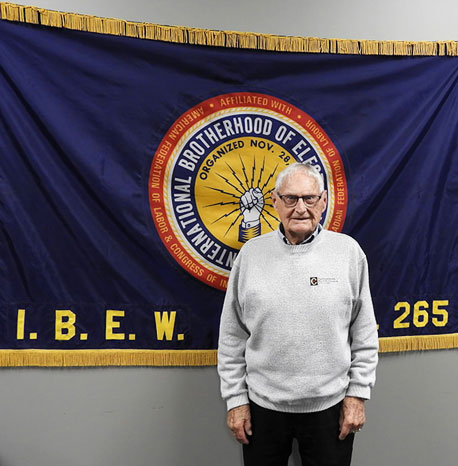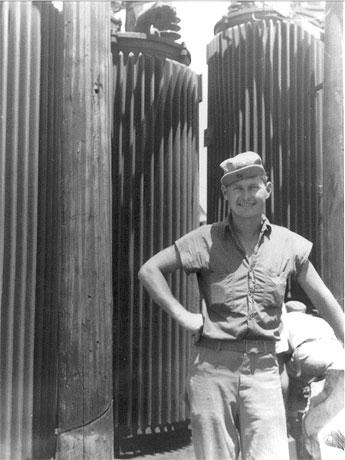Every year, the IBEW hands out hundreds –yes hundreds—of 70-year pins to men and women marking seven decades as members of the Brotherhood.

|
| Stentz retired after 87 years of electrical work, starting at age 6 working for his dad. He is one of a very few –possibly the only-- 70-year pin recipient still on the job when it arrived.
|
But how many arrive before retirement?
There is now at least one.
After nearly 90 years doing electrical work, Lincoln, Neb., Local 265 member Norm “Pinky” Stentz is out of work.
“I’m an old buzzard,” he said.
Stentz, 95, is a second-generation member of Local 265. His father, Howard, was president of the Local 60-odd years ago. He got into the business in 1929, when Stentz was only 6 years old, and times being what they were, it wasn’t long until he was helping his father out on jobs.
“I was very close to my dad.He’s the one who nicknamed me Pinky the first time he saw me,” he said. “I had a brother who wanted no part of it. So old Pinky had to help his dad. I crawled under buildings where he couldn’t get in.”
By 1931, his father taught him all the tools and had him fetch them out of the Model T they had converted into a work truck. By his tenth birthday in 1933 he was drilling holes in joists and studs with a brace and bit for the knob and tube work.
“My dad was very much a perfectionist. You put a tube on backwards, you had to tear the whole thing out and replace the whole darn thing,” he said.
“You have to understand, back in those days you could do things you can’t do today with a 10-year-old kid on a construction site,” he said, recalling one job at the Arrow Aircraft factory, nearing midnight, when his father was pulling fish tape from the panel in outbuilding to make a new service on the factory floor.
“Well I got sleepy because it took a while for him to walk over, and somehow, I let go of that fish tape and it all coiled up onto the hot wires,” Stentz said. “It looked there was 25 [blind] welders were working in there. The sparks were flying.”
In the mid-30s, President Franklin D. Roosevelt gave out bonuses to veterans of World War I, including Howard. With the money, they got rid of the Model T and bought a used 1929 pickup and replaced the plumber’s candle they used for soldering with a brand-new gas blowtorch and a matching iron.
“We thought we were really in tall cotton then,” Stentz said.
By the time World War II arrived, Stentz’ father had shuttered the business and gone to work for the Works Project Administration upgrading power houses and electrifying farms through the Rural Electrification Administration. That’s when Pinky wired up his first home by himself, sleeping in his work clothes because there wasn’t any heat.
“The only thing I forgot to do was tie in a Romex circuit between one half of the basement and the other,” he said. “It passed inspection.”
Not long after that, some boys from Lincoln came back from basic training before heading off to war.
“They had brand new shoes, clean handkerchiefs, and white undershirts. I got holes in my shoes with cardboard and yellow shirts and boy, I thought, that’s for me,” he said.

|
| Stentz in front of bullet-riddled transformers in Suwon, South Korea in 1952.
|
Stentz joined the Navy in 1940 as a seaman, but he soon told the electrician’s mate he knew “something about electrical.” The mate told him to draw a three-way circuit “the legal way.” Stentz’s drawing was good enough to get him a promotion to 3rd class electrician’s mate. “The lowest you could be,” he recalled.
By 1943 he was transferred to the newly commissioned USS Independence, an aircraft carrier on its way to the Pacific. His final station was topside, working on the bridge and searchlights. He was there when the ship was torpedoed during the Battle of Tarawa. The ship went in for repairs in San Francisco and was sent back out to support attacks on Okinawa and Philippines and was part of the fleet that destroyed the last remnants of the Japanese Mobile Fleet in the Battle of Leyte Gulf.
“I went through all that crap,” he said.
After the war, Stentz returned home to Nebraska and got a job at Industrial Electric. He volunteered to come in on weekends so could learn about winding motors. Then one day the owner, a Mr. Dignan, asked if he’d like to learn about estimating.
“He showed me the big NECA book and it was all way over my head. So, he started me out with a building with one light and one switch, and after I mastered material costs and how to labor it, he took me to 2-fuse service and up from there,” he said.
But the greatest reward he got from Dignan, Stentz said, was in 1947, when he came by the boss’s house one weekend for some extra work. He was driving his bright yellow 1934 Ford Roadster when Dignan’s daughter came by to say hello.
“Down came a good-looking girl, dark eyes, long hair. ‘You must be Pinky,’ she said. I said ‘Yeah.’ ‘My dad told me about you. Incidentally I sure that like that car you got there,” Stentz recalled. “Long story short, I married his daughter, quit him and went to work at Commonwealth Electric.”
It was at Commonwealth that Stentz made the permanent shift from the field to the office. He was called back into service from 1953 to 1955 in the 1st Marine Airwing. The unit included Marine Aircraft Group 33, whose pilots included future astronaut and U.S. senator John Glenn, Red Sox hall-of-famer Ted Williams and future Tonight Show sidekick Ed McMahon. Stentz maintained the unit’s generators before he was sent to work with the Korean power company rebuilding transformers.
“I have pictures showing electricians with no shoes on making connections with barbed wire because it was all we had,” he said.
When he returned home to Commonwealth, Stentz was the only estimator who came from the field, and at first the room full of engineers weren’t sure what they had.
“I was very humble. They finally accepted me and said, ‘You will make a good man.’ We had a chief engineer who took me under his wing. He worked mainly power houses, but I did everything,” Stentz said.
Within a few years, Stentz said he was not only estimating jobs, he was given the go-ahead to bid them. One of his first was a power house addition. His bid was the lowest.
“I don’t know if we won by a lot or a little but, man, I thought I was really nifty,” he said.
But when he got home and showed the take-off to the boss, he asked a single question: where are the motor connections?
“I didn’t have a damn one in there! He could have fired me. He could have done all kinds of things. He just said, ‘You better find a good super for the job,’” Stentz said. “And I’ll tell you what, motor connections are tattooed in my head. I look at them connections to this day.”
It was in the late 50s that Stentz went from estimating and bidding to designing projects.
“He became one of Commonwealth’s best engineers and he never spent a day in a college classroom,” said Local 265 Business Manager John Callahan.
He drew up everything from office buildings to a 15 mw co-generation plant for Archer Daniels Midland.
“I would like to say they put it online in the 80s and they have never had a nickel’s worth of trouble with it, but I’m not 100 percent sure” Stentz said.
One of his favorite projects, he said, was a design for Molex’s Lincoln factory with a 15,000 volt service and 2,500 amp panels in 18 locations in the plant.
“They have added on additions and everything and they have never had to increase electrical capacity because it was all right there from the beginning,” he said.
Stentz retired in August and he’s not sure what his next chapter will be. At least one of his children, an engineer in the Navy, retired before he did. But after 89 years doing electrical work, his mind, he thinks often of the people who got him here.
“I contribute my success and know-how to the owners of Commonwealth and the engineers that taught me. They were very nice,” he said. “But I worked real hard. When I got off from work I didn’t go to beer joints. I went home and studied. I think I earned my stripes.”